2014新版小学四年级英语上册复习知识点归纳-
- 格式:doc
- 大小:58.50 KB
- 文档页数:7
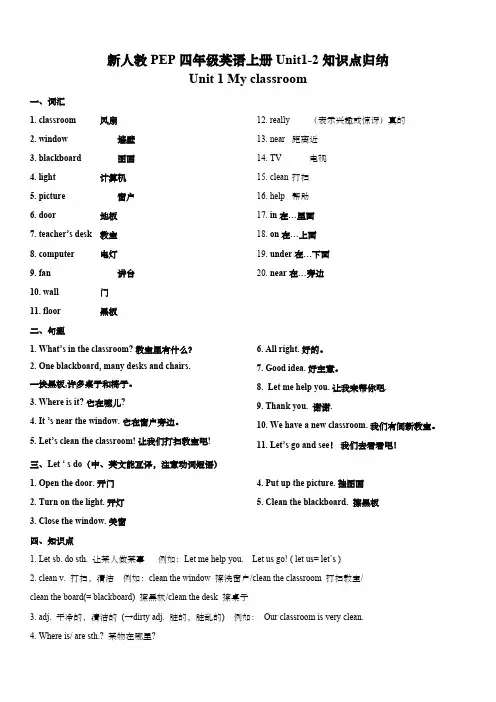
新人教PEP四年级英语上册Unit1-2知识点归纳Unit 1 My classroom一、词汇1. classroom 风扇2. window 墙壁3. blackboard 图画4. light 计算机5. picture 窗户6. door 地板7. teacher’s desk教室8. computer 电灯9. fan 讲台10. wall 门11. floor 黑板12. really (表示兴趣或惊讶)真的13. near 距离近14. TV 电视15. clean 打扫16. help 帮助17. in 在…里面18. on 在…上面19. under 在…下面20. near 在…旁边二、句型1. What’s in the classroom? 教室里有什么?2. One blackboard, many desks and chairs.一块黑板,许多桌子和椅子。
3. Where is it? 它在哪儿?4. It ’s near the window. 它在窗户旁边。
5. Let’s clean the classroom! 让我们打扫教室吧!6. All right. 好的。
7. Good idea. 好主意。
8. Let me help you. 让我来帮你吧.9. Thank you. 谢谢.10. We have a new classroom. 我们有间新教室。
11. Let’s go and see!我们去看看吧!三、Let ‘ s do(中、英文能互译,注意动词短语)1. Open the door. 开门2. Turn on the light. 开灯3. Close the window. 关窗4. Put up the picture. 挂图画5. Clean the blackboard. 擦黑板四、知识点1. Let sb. do sth. 让某人做某事例如:Let me help you. Let us go! ( let us= let’s )2. clean v. 打扫,清洁例如:clean the window 擦洗窗户/clean the classroom 打扫教室/ clean the board(= blackboard) 擦黑板/clean the desk 擦桌子3. adj. 干净的,清洁的(→dirty adj. 脏的,脏乱的) 例如:Our classroom is very clean.4. Where is/ are sth.? 某物在哪里?例如:Where is my book?/Where is his pen?/Where are her friends?/Where are their chairs?5. open the door sweep the floor clean the board6. 表示拥有have 和there be句型的用法1)通常,表示某人拥有某物时,用have 我有一只小猫。
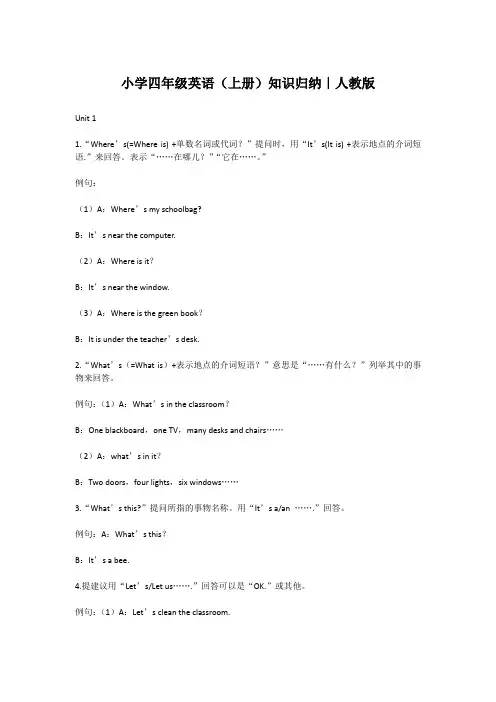
小学四年级英语(上册)知识归纳|人教版Unit 11.“Where’s(=Where is) +单数名词或代词?”提问时,用“It’s(It is) +表示地点的介词短语.”来回答。
表示“……在哪儿?”“它在……。
”例句:(1)A:Where’s my schoolbag?B:It’s near the computer.(2)A:Where is it?B:It’s near the window.(3)A:Where is the green book?B:It is under the teacher’s desk.2.“What’s(=What is)+表示地点的介词短语?”意思是“……有什么?”列举其中的事物来回答。
例句:(1)A:What’s in the classroom?B:One blackboard,one TV,many desks and chairs……(2)A:what’s in it?B:Two doors,four lights,six windows……3.“What’s this?”提问所指的事物名称。
用“It’s a/an …….”回答。
例句:A:What’s this?B:It’s a bee.4.提建议用“Let’s/Let us…….”回答可以是“OK.”或其他。
例句:(1)A:Let’s clean the classroom.B:OK.(2)A:Let me help you.B:Thank you.5.祈使句。
以动词原形开头的句子,表达请求、命令或禁止等语气。
例句:(1)Open the door.(2)Turn on the light.(3)Close the window.(4)Put up the picture.(5)Clean the blackboard.6.介绍某物用“This is…….”开头. 例如:(1)This is the new classroom.(2)This is my classroom.(3)This is my room.7.其他句型。
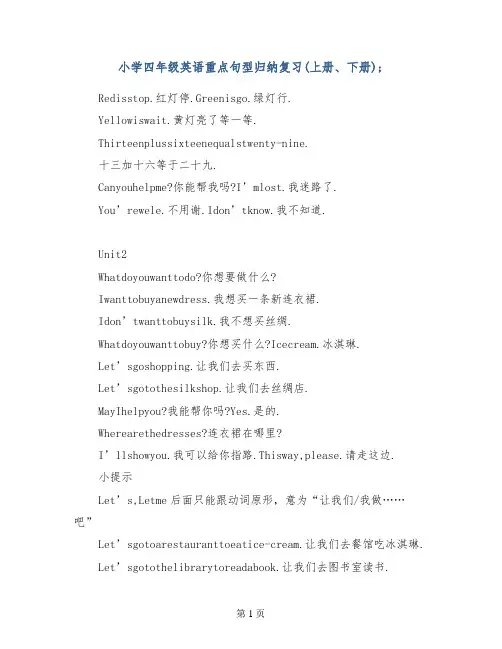
小学四年级英语重点句型归纳复习(上册、下册);Redisstop.红灯停.Greenisgo.绿灯行.Yellowiswait.黄灯亮了等一等.Thirteenplussixteenequalstwenty-nine.十三加十六等于二十九.Canyouhelpme?你能帮我吗?I’mlost.我迷路了.You’rewele.不用谢.Idon’tknow.我不知道.Unit2Whatdoyouwanttodo?你想要做什么?Iwanttobuyanewdress.我想买一条新连衣裙.I don’twanttobuysilk.我不想买丝绸.Whatdoyouwanttobuy?你想买什么?Icecream.冰淇琳.Let’sgoshopping.让我们去买东西.Let’sgotothesilkshop.让我们去丝绸店.MayIhelpyou?我能帮你吗?Yes.是的.Wherearethedresses?连衣裙在哪里?I’llshowyou.我可以给你指路.Thisway,please.请走这边.小提示Let’s,Letme后面只能跟动词原形,意为“让我们/我做……吧”Le t’sgotoarestauranttoeatice-cream.让我们去餐馆吃冰淇琳.Let’sgotothelibrarytoreadabook.让我们去图书室读书.Awaiterworksinarestaurant.服务员在餐馆工作. Aclerkworksinastore.办事员在商店工作. Abusinessmanworksinaofficebuilding.商人在办公楼工作. Winter:Theweatheriscoldandsnowy.天气是寒冷的和多雪的Spring:Itiswarmandrainy.天气是暖和的和多雨的. Summer:It’shotandsunny.天气是炎热的和晴朗的.; Autumn:Theweatheriswindyandcloudy.天气是多风的和多云的.Whereareyougoing?你要去哪里? Tothebicycleshopacrossthestreet.去街对面的自行车商店. Why?为什么.Mybikeisbroken.我的自行车坏了. Ineedanewchain.我需要一个新链条.Acathasfur,pawsandatail.猫有毛皮、爪子和一条尾巴。
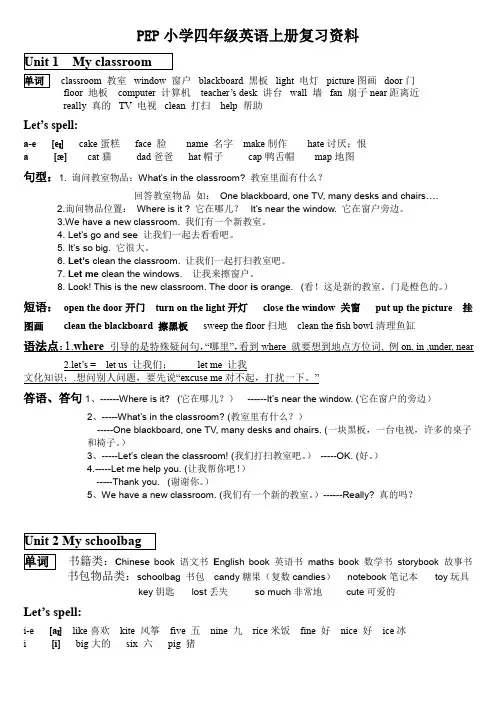
PEP小学四年级英语上册复习资料classroom 教室window 窗户blackboard 黑板light 电灯picture图画door门floor 地板computer 计算机teacher’s desk 讲台wall 墙fan 扇子near距离近really 真的TV 电视clean 打扫help 帮助Let’s spell:a-e [eɪ] cake蛋糕face 脸name 名字make制作hate讨厌;恨a [æ] cat猫dad爸爸hat帽子cap鸭舌帽map地图句型:1. 询问教室物品:What’s in the classroom? 教室里面有什么?回答教室物品如:One blackboard, one TV, many desks and chairs….2.询问物品位置:Where is it ? 它在哪儿?It’s near the window. 它在窗户旁边。
3.We have a new classroom. 我们有一个新教室。
4. Let’s go and see 让我们一起去看看吧。
5. It’s so big. 它很大。
6. Let’s clean the classroom. 让我们一起打扫教室吧。
7. Let me clean the windows. 让我来擦窗户。
8. Look! This is the new classroom. The door is orange. (看!这是新的教室。
门是橙色的。
)短语:open the door开门turn on the light开灯close the window 关窗put up the picture 挂图画clean the blackboard 擦黑板sweep the floor扫地clean the fish bowl清理鱼缸语法点:1.where 引导的是特殊疑问句,“哪里”,看到where 就要想到地点方位词, 例on, in ,under, near2.let’s = let u s 让我们;let me 让我文化知识:.想问别人问题,要先说“excuse me对不起,打扰一下。
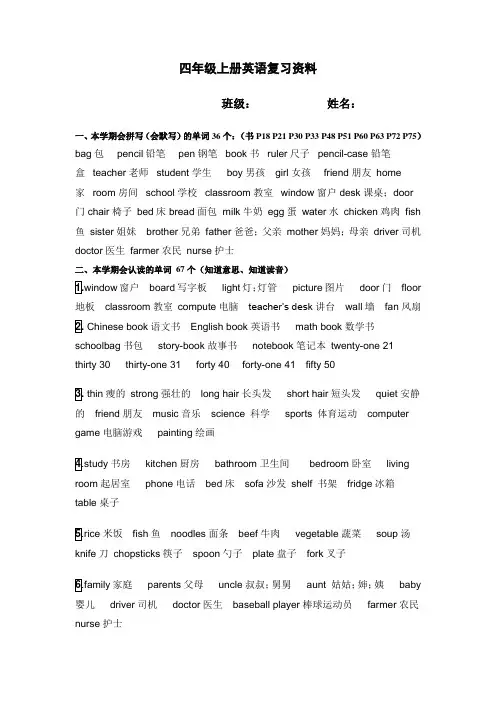
四年级上册英语复习资料班级:姓名:一、本学期会拼写(会默写)的单词36个:(书P18 P21 P30 P33 P48 P51 P60 P63 P72 P75)bag包pencil铅笔pen钢笔book书ruler尺子pencil-case铅笔盒teacher老师student学生boy男孩girl女孩friend朋友home家room房间school学校classroom教室window窗户 desk课桌;door门 chair椅子bed床 bread面包 milk牛奶egg蛋water水chicken鸡肉fish 鱼sister姐妹brother兄弟father爸爸;父亲mother妈妈;母亲driver司机doctor医生farmer农民nurse护士二、本学期会认读的单词67个(知道意思、知道读音)window窗户board写字板light灯;灯管picture图片door门floor 地板classroom教室compute电脑teacher’s desk讲台wall墙fan风扇Chinese book语文书English book英语书math book数学书schoolbag书包story-book故事书notebook笔记本twenty-one 21thirty 30 thirty-one 31 forty 40 forty-one 41 fifty 50thin瘦的strong强壮的long hair长头发short hair短头发quiet安静的friend朋友music音乐science 科学sports 体育运动computer game电脑游戏painting绘画书房kitchen厨房bathroom卫生间bedroom卧室living room起居室phone电话bed床sofa沙发shelf 书架fridge冰箱table桌子米饭fish鱼noodles面条beef牛肉vegetable蔬菜soup汤knife刀chopsticks筷子spoon勺子plate盘子fork叉子家庭parents父母uncle叔叔;舅舅aunt 姑姑;婶;姨baby 婴儿driver司机doctor医生baseball player棒球运动员farmer农民nurse护士三、短语1. open the door 开门turn on the light 开灯sweep the floor 扫地clean the window 擦窗户put up the picture 挂图画clean the board 擦黑板2. put your notebook under your bag. 把你的笔记本放在你的包下。
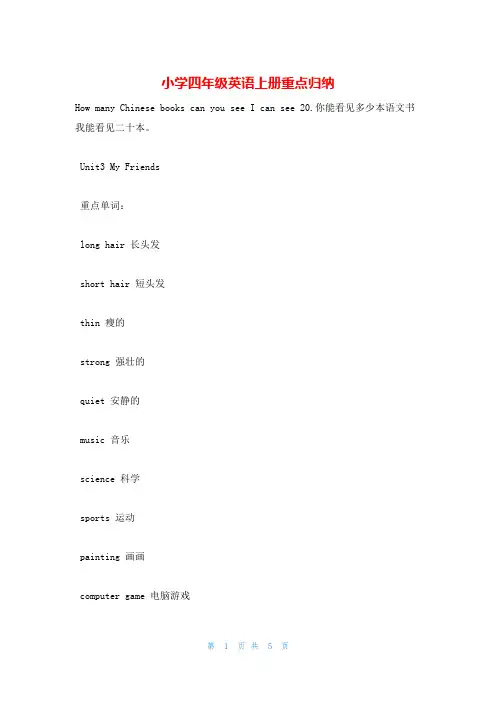
小学四年级英语上册重点归纳How many Chinese books can you see I can see 20.你能看见多少本语文书我能看见二十本。
Unit3 My Friends重点单词:long hair 长头发short hair 短头发thin 瘦的strong 强壮的quiet 安静的music 音乐science 科学sports 运动painting 画画computer game 电脑游戏teacher 老师student 学生boy 男孩girl 女孩friend.朋友重点句型:My friend is strong. He has short hair. He likes sports.我的朋友很强壮,他有着短头发,他爱运动。
I like music. She likes painting.我喜欢音乐,她喜欢绘画。
Whats his name His name is Zhang Peng.他叫什么名字他叫张鹏。
Unit4 My Home重点单词:study 学习kitchen 厨房bathroom 浴室bedroom 卧室living room 客厅home 家classroom 教室phone 电话bed 床sofa 沙发shelf 架子,层fridge 冰箱table 桌子重点句型:Welcome to my home.欢迎来我家。
This is my house. Its big.这是我的房子,它很大。
Where are the keys They are in the door.钥匙在哪里在门上。
Are they near the tableYes, they are. /No, they arent.他们在桌子附近吗是的/不是。
Is it on the shelf Yes, it is. /No, it isnt.在架子上吗是的/不在。
Unit5 What would you like重点单词:rice 米饭fish 鱼noodle 面条beef 牛肉soup 汤vegetable 蔬菜knife 刀chopsticks 筷子spoon 勺子plate 盘子fork 叉子重点句型:What would you like for lunch Id like some beef. 你中餐想吃什么我想吃些牛肉。
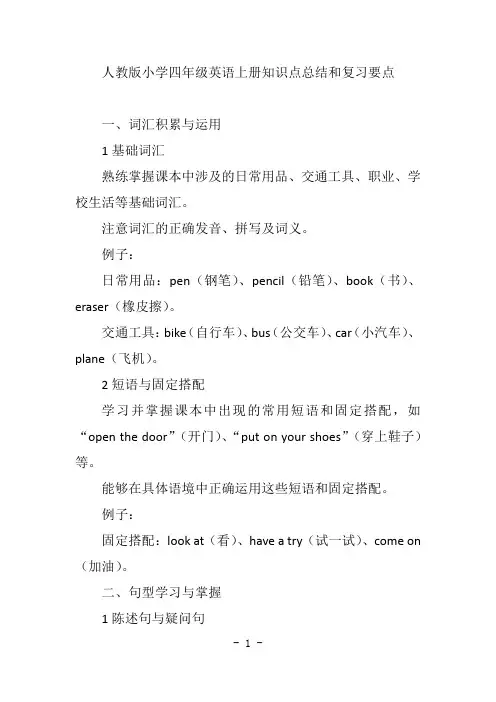
人教版小学四年级英语上册知识点总结和复习要点一、词汇积累与运用1基础词汇熟练掌握课本中涉及的日常用品、交通工具、职业、学校生活等基础词汇。
注意词汇的正确发音、拼写及词义。
例子:日常用品:pen(钢笔)、pencil(铅笔)、book(书)、eraser(橡皮擦)。
交通工具:bike(自行车)、bus(公交车)、car(小汽车)、plane(飞机)。
2短语与固定搭配学习并掌握课本中出现的常用短语和固定搭配,如“open the door”(开门)、“put on your shoes”(穿上鞋子)等。
能够在具体语境中正确运用这些短语和固定搭配。
例子:固定搭配:look at(看)、have a try(试一试)、come on (加油)。
二、句型学习与掌握1陈述句与疑问句熟练掌握陈述句和疑问句的基本结构,能够正确运用主语、谓语和宾语。
学会使用疑问句询问信息,如“What’s this?”(这是什么?)和“Where is your book?”(你的书在哪里?)。
例子:陈述句:I have a new pencil box.(我有一个新的铅笔盒。
)疑问句:Do you like playing football?(你喜欢踢足球吗?)2特殊疑问句学习并掌握“What color is it?”(它是什么颜色的?)、“How old are you?”(你多大了?)等特殊疑问句及其回答方式。
能够根据问题提供正确的信息。
例子:特殊疑问句:What do you usually do on weekends?(你周末通常做什么?)回答:I usually go to the park with my family.(我通常和家人去公园。
)三、语音与语调规则1元音与辅音发音复习并巩固元音和辅音的发音规则,注意发音的准确性和清晰度。
练习发音相近或容易混淆的词汇,提高发音敏感度。
发音练习:正确区分“thin”(瘦的)和“thing”(事情)的发音。
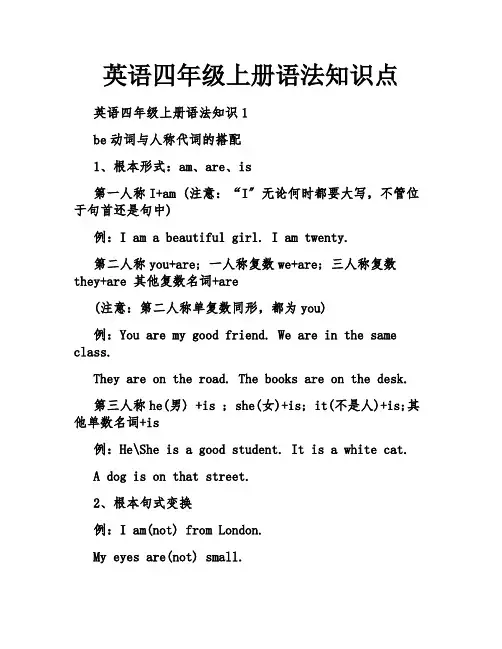
英语四年级上册语法知识点英语四年级上册语法知识1be动词与人称代词的搭配1、根本形式:am、are、is第一人称I+am (注意:“I〞无论何时都要大写,不管位于句首还是句中)例:I am a beautiful girl. I am twenty.第二人称you+are; 一人称复数we+are; 三人称复数they+are 其他复数名词+are(注意:第二人称单复数同形,都为you)例:You are my good friend. We are in the same class.They are on the road. The books are on the desk.第三人称he(男) +is ; she(女)+is; it(不是人)+is;其他单数名词+is例:He\She is a good student. It is a white cat.A dog is on that street.2、根本句式变换例:I am(not) from London.My eyes are(not) small.My hair is(not) long.Am I a Chniese? 答复:肯定:Yes, you are. 否认:No, you aren’t.Is the cat fat? 答复:肯定:Yes, it is. 否认: No, it isn’t.注意:在一般疑问答复中,肯定答复除I’m不可简写,否认答复均可简写。
英语四年级上册语法知识2一般疑问句及特殊疑问句句子根本是:简单陈述句,由简单陈述句转变成肯定句,否认句,疑问句。
疑问句是用来提出问题。
英语中有四种疑问句: 一般疑问句、特殊疑问句、选择疑问句和反意疑问句。
我们现在已经接触到了前两种疑问句。
1、一般疑问句:英语中要用 yes和no 来答复的疑问句叫一般疑问句。
如:1)Is it hot ? Yes, it is .\No,it isn’t. ——be动词引导2)Is it a car ?Yes, it is .\No,it isn’t . ——be动词引导3)Is this your ruler ?Yes, it is .\No, itisn’t .—— be动词引导4)Do you like bananas ?——含实义动词Yes, I like bananas. \ No,I don’t like bananas.或Yes, I do.\ No,I don’t5)Can Tom see a dogl ?——含情态动词Yes , Tom can see a dog.\No,Tom can’t see a dog.或Yes , he can.\ No,he can’t.陈述句(肯定句,否认句,一般疑问句)的转变规律:1.肯定句:2.否认句:3. 一般疑问句及肯否认答复1) 主语+be动词+….1) 主语+be动词+not+….1)be动词+主语+…?Yes,主语+be动词./No,主语+be动词+not.I am a teacher. I amnot a teacher. Are you a teacher?--Yes, I am./ No, I am not.My mother is thin. My mother is not /isn’t thin. Is your mother thin?--Yes, she is./ No,she isn’t.They are friend. They are not/aren’t friend .Are they friend?--Yes. they are./ No,they aren’t.2) 主语+情态动词can+… 2) 主语+情态动词can+not+….2)情态动词can+主语+…?Yes,主语+情态动词can/No,主语+情态动词can+ notHe can jump. He cannot/can’tjump. Can he jump?--Yes,he can./ No,he can’t.3)助动词do/does+主语+…. 动词原形+….动词原形?Yes,主语+助动词do/does. No,主语+助动词do/does+not.He likes to eat apples. He doesn’t like to eat apples. Does he like to eat apples?Yes,he does./ No,he doesn’t.2、祈使句:表示请求、命令、建议或劝告等的句子叫祈使句,主语you常省略。
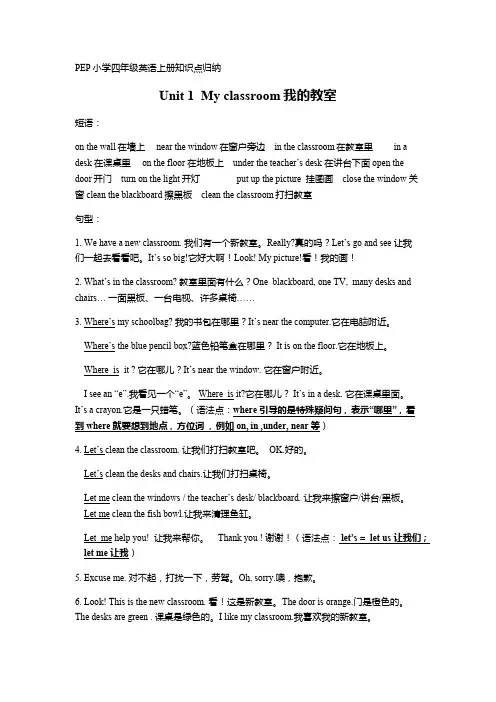
PEP小学四年级英语上册知识点归纳Unit 1 My classroom我的教室短语:on the wall在墙上 near the window在窗户旁边 in the classroom在教室里 in a desk 在课桌里 on the floor 在地板上under the teacher’s desk 在讲台下面open thedoor开门 turn on the light开灯 put up the picture 挂图画 close the window 关窗clean the blackboard 擦黑板 clean the classroom打扫教室句型:1. We have a new classroom. 我们有一个新教室。
Really?真的吗?Let’s go and see 让我们一起去看看吧。
It’s so big!它好大啊!Look! My picture!看!我的画!2. What’s in the classroom? 教室里面有什么?One blackboard, one TV, many desks and chairs…一面黑板、一台电视、许多桌椅……3. Where’s my schoolbag? 我的书包在哪里?It’s near the computer.它在电脑附近。
Where’s the blue pencil box?蓝色铅笔盒在哪里? It is on the floor.它在地板上。
Where is it ? 它在哪儿?It’s near the window. 它在窗户附近。
I see an “e”.我看见一个“e”。
Where is it?它在哪儿?It’s in a desk. 它在课桌里面。
It’s a crayon.它是一只蜡笔。
(语法点:where 引导的是特殊疑问句,表示“哪里”,看到where 就要想到地点,方位词,例如on, in ,under, near等)4. Let’s clean the classroom. 让我们打扫教室吧。
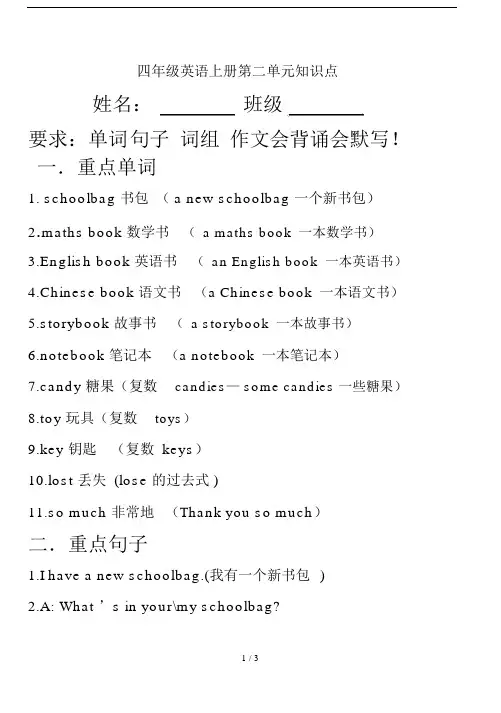
四年级英语上册第二单元知识点姓名:班级要求:单词句子词组作文会背诵会默写!一.重点单词1. schoolbag 书包( a new schoolbag 一个新书包)2.maths book 数学书(a maths book一本数学书)3.English book 英语书(an English book一本英语书)4.Chinese book 语文书(a Chinese book一本语文书)5.storybook 故事书(a storybook一本故事书)6.notebook 笔记本(a notebook一本笔记本)7.candy 糖果(复数candies— some candies 一些糖果)8.toy 玩具(复数toys)9.key 钥匙(复数 keys)10.lost 丢失 (lose 的过去式 )11.so much 非常地(Thank you so much)二.重点句子1.I have a new schoolbag.(我有一个新书包)2.A: What ’s in your\my schoolbag?B:An English book, a maths book, a Chinese book and three storybooks.B:Three keys, two toys ,some candies and a notebook.A:在你的我的书包里面有什么?B:一本英语书 ,一本数学书 ,一本语文书和三本故事书。
三把钥匙 ,两个玩具 ,一些糖块和一本笔记本。
3.Put your Chinese book in your desk.把你的语文书放在你的书桌里。
4.Put your pencil box on your English book.把你的铅笔盒放在英语书上。
5.Put your maths book under your schoolbag.把你的数学书放在你的书包下面。
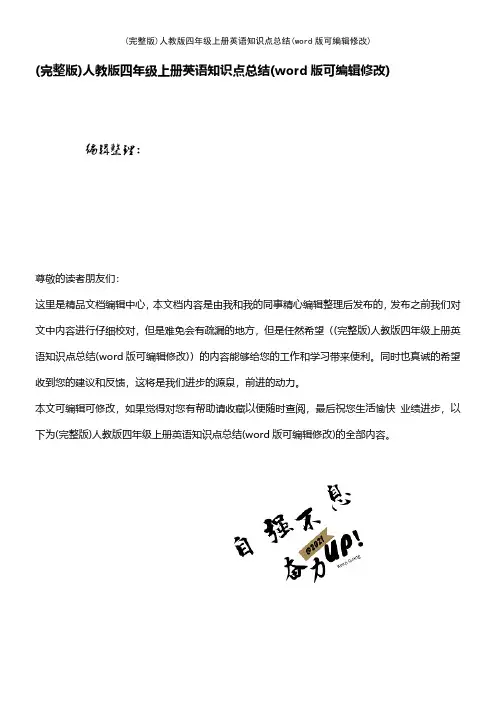
(完整版)人教版四年级上册英语知识点总结(word版可编辑修改)编辑整理:尊敬的读者朋友们:这里是精品文档编辑中心,本文档内容是由我和我的同事精心编辑整理后发布的,发布之前我们对文中内容进行仔细校对,但是难免会有疏漏的地方,但是任然希望((完整版)人教版四年级上册英语知识点总结(word版可编辑修改))的内容能够给您的工作和学习带来便利。
同时也真诚的希望收到您的建议和反馈,这将是我们进步的源泉,前进的动力。
本文可编辑可修改,如果觉得对您有帮助请收藏以便随时查阅,最后祝您生活愉快业绩进步,以下为(完整版)人教版四年级上册英语知识点总结(word版可编辑修改)的全部内容。
小学四年级英语上册基础知识汇总Unit 1 My classroom单词classroom 教室 window 窗户 blackboard 黑板 light 电灯 picture 图画 door 门floor 地板 computer 计算机 teacher’s desk 讲台 wall 墙 fan 扇子near 距离近 really 真的 TV 电视 clean 打扫 help 帮助Let ’ s spell:a— - e [eɒ] cake 蛋糕 face 脸 name 名字 make 制作 hate 讨厌date 日期a [æ] cat 猫 dad 爸爸 hat 帽子 cap 棒球帽 map 地图句型:1 We have a new classroom。
我们有一个新教室。
2 Let’s go and see 让我们一起去看看吧。
3 What’s in the classroom? 教室里面有什么?One blackboard, one TV, many desks and chairs.4 Where is it ?它在哪儿? It’s near the window。
它在窗户旁边。
5 It’s so big。
它很大.6 Let’s clean the classroom. 让我们一起打扫教室吧。
小学四年级英语重点句型归纳复习(上册、下册)Red is stop. 红灯停. Green is go.绿灯行.Yellow is wait. 黄灯亮了等一等.Thirteen plus sixteen equals twenty-nine.十三加十六等于二十九.Can you help me?你能帮我吗? I’m lost.我迷路了.You’re welcome.不用谢. I don’t know.我不知道.Unit2What do you want to do? 你想要做什么?I want to buy a new dress. 我想买一条新连衣裙.I don’t want to buy silk. 我不想买丝绸.What do you want to buy?你想买什么?Ice cream.冰淇琳.Let’s go shopping. 让我们去买东西.Let’s go to the silk shop. 让我们去丝绸店.May I help you? 我能帮你吗? Yes. 是的.Where are the dresses? 连衣裙在哪里?I’ll show you.我可以给你指路.This way,please.请走这边.小提示:Let’s,Let me后面只能跟动词原形,意为“让我们/我做……吧”Let’s go to a restaurant to eat ice-cream.让我们去餐馆吃冰淇琳.Let’s go to the library to read a book.让我们去图书室读书.A waiter works in a restaurant.服务员在餐馆工作.A clerk works in a store. 办事员在商店工作.A businessman works in a office building.商人在办公楼工作.Winter: The weather is cold and snowy.天气是寒冷的和多雪的Spring: It is warm and rainy.天气是暖和的和多雨的.Summer: It’s hot and sunny. 天气是炎热的和晴朗的.Autumn: The weather is windy and cloudy.天气是多风的和多云的.Where are you going? 你要去哪里?To the bicycle shop across the street.去街对面的自行车商店.Why? 为什么. My bike is broken.我的自行车坏了.I need a new chain. 我需要一个新链条.A cat has fur,paws and a tail.猫有毛皮、爪子和一条尾巴。
四年级上册英语第一单元知识点总结(经典版)编制人:__________________审核人:__________________审批人:__________________编制单位:__________________编制时间:____年____月____日序言下载提示:该文档是本店铺精心编制而成的,希望大家下载后,能够帮助大家解决实际问题。
文档下载后可定制修改,请根据实际需要进行调整和使用,谢谢!并且,本店铺为大家提供各种类型的经典范文,如工作报告、致辞讲话、条据书信、合同范本、规章制度、应急预案、心得体会、教学资料、作文大全、其他范文等等,想了解不同范文格式和写法,敬请关注!Download tips: This document is carefully compiled by this editor. I hope that after you download it, it can help you solve practical problems. The document can be customized and modified after downloading, please adjust and use it according to actual needs, thank you!Moreover, our store provides various types of classic sample essays, such as work reports, speeches, policy letters, contract templates, rules and regulations, emergency plans, insights, teaching materials, essay encyclopedias, and other sample essays. If you want to learn about different sample formats and writing methods, please pay attention!四年级上册英语第一单元知识点总结人教版四年级上册英语第一单元知识点总结在四年级这个阶段不仅仅只学习英语单词,也让学生适当的接触句型,学到更多的知识,学习深度也由浅变深。
PEP小学四年级英语上册第一单元知识点总结Unit 1 My classroom单词classroom 教室window 窗户blackboard 黑板light 电灯picture图画door门floor 地板computer 计算机teacher’s desk 讲台wall墙fan 扇子near 距离近really 真的TV 电视clean 打扫help 帮助句型:We have a new classroom. 我们有一个新教室。
Let’s go and see 让我们一起去看看吧。
What’s in the classroom? 教室里面有什么?One blackboard, one TV, many desks and chairs.Where is it ? 它在哪儿?It’s near the window. 它在窗户旁边。
It’s so big. 它很大。
Let’s clean the classroom. 让我们一起打扫教室吧。
Let me clean the windows. . 让我来擦窗户。
Look! This is the new classroom. The door is orange.(看!这是新的教室。
门是橙色的。
)短语:1.地点类:on the wall在墙上near the window在窗户旁边in the classroom在教室里on the fan在风扇上near the computer在计算机旁边2. 动作类:3. clean the desks and chairs 清洁桌椅clean the windows擦窗户clean the fish bowl清理鱼缸open the door开门turn on the light开灯sweep the floor扫地put up the picture张帖图画clean the classroom 打扫教室clean the teacher’s desk 清洁讲台close the window 关窗Turn on the light 开灯put up the picture 挂图画clean the blackboard 擦黑板3.其他类:4.a new classroom一间新教室excuse me 劳驾,对不起语法点:where 引导的是特殊疑问句,“哪里”,看到where 就要想到地点,方位词,例如on, in ,under, near等语法点:let’s =let us 让我们;let me 让我文化知识:.想问别人问题,要先说“excuse me对不起,打扰一下。
一、词汇部分(一)四会单词1.classroom教室2.window窗户3.blackboard黑板4.light电灯5.picture图画6.door门7.teacher’sdesk讲台puter计算机,电脑9.fan风扇10.wall墙壁11.floor地板(二)三会单词1.really真的2.near距离近电视4.clean打扫5.help帮助(三)四会词组1.near the computer在电脑附近2.a new classroom(一间)新教室3.in the classroom 在教室里4.go and see 去看看(四)三会词组1.clean the desks and chairs擦书桌和椅子/擦桌椅2.clean the windows擦窗户3.fish bowl鱼缸4.clean the blackboard擦黑板5.clean the classroom打扫教室6.clean the teacher’s desk擦讲台二、情景会话(句型)1.询问教室、房间或物品里有什么What’s in……? ……里面有什么?答语回答具体物品、东西例如:What’s in the classroom?教室里有什么?One blackboard, one TV, many desks and chairs.一面黑板、一台电视、许多书桌和椅子。
2.询问物品的位置:Where is the ……?......在哪里?答语结构:It is in/on/under/near the……?例如:Where is my schoolbag?我的书包在哪里?It’s near the computer.它在电脑附近。
3.提建议:Let’s + 动词(词组)让我们……吧!Let me +动词(词组)让我……吧!例如:Let’s clean the classroom.让我们打扫教室吧!Let me clean the Windows. 让我……吧!三、Let’s do (P5页)1.Open the door. 开门。
四年级上册英语复习资料四年级下册英语复习资料班级_________ 姓名___________ Unit 1 My classroom一.词组1.near the windows2.clean the desk3.clean the fish bowl靠近窗户擦桌子清洗鱼缸4.clean the blackboard5.clean teacher’s desk6.turn on the light擦黑板擦讲台桌开灯7.turn off the light 8. put up the pictures 9.open the door关灯张贴图画开门10.close the door关门二.知识点1. 元音+辅音+e 元音元音读字母音如:a读/e?/cake face name make date hate game race Kate lake 元音+辅音读短元音如:a读/?/cat dad hat map cap2. in 在……里面on在……上面near在……附近under在……下面It’s in/on/near/under+the+名词如:It’s in the classroom. 它在教室里3. colours(颜色):red pink blue brown black white yellow purple green orange 红色粉色蓝色棕色黑色白色黄色紫色绿色橘黄色4.Let me 表示“让我……”Let me+动词原形+其他. 如:Let me clean the blackboard.Let’s =Let us表示“让我们……”Let’s+动词原形+其他. 如:Let’s clean the classroom.三.重点句子1. Where is it? It’s near the window. 它在哪?它在窗户附近。
2. What’s in the classroom? 教室里有什么?A door, three chairs, two desks and a computer.一扇门,三把椅子,两张桌子和一台电脑。
人教版小学英语四年级上册单元知识点归纳总结 单元 主题 核心词汇 关键句型 语法点
Unit 1 My classroom classroom, window, blackboard, light, picture, door, floor, computer, teacher's desk, wall, fan, TV
1. We have a new classroom. 1. where引导的特殊疑问句
2. What's in the classroom? 2. 方位词(on, in, under, near)
3. Where is it?
4. Let's clean the classroom. Unit 2 My schoolbag schoolbag, Chinese book, English book, maths book, storybook, candy, notebook, toy, key, lost, cute
1. I have a new schoolbag. 1. what colour引导的特殊疑问句
2. What's in your schoolbag?
2. 颜色
词汇
3. What colour is it?
Unit 3 My friends strong, friendly, quiet, hair, shoes, glasses, his, her, or, right, hat 1. He is tall and strong. 形容词的运用 2. He has short hair.
3. My friend has glasses and his shoes are blue.
Unit 4 My home home, room, bedroom, bathroom, living room, kitchen, near, on, in, under 1. This is my home. 地点词汇与方位词的结合
1 2013 PEP小学四年级英语上册复习之 "葵花宝典” Unit 1 My classroom 单词 classroom 教室 window 窗户 blackboard 黑板 light 电灯 picture图画 door门 floor 地板 computer 计算机 teacher’s desk 讲台 wall 墙 fan 扇子 near 距离近 really 真的 TV 电视 clean 打扫 help 帮助 Let’s spell: a-e [eɪ] cake蛋糕 face 脸 name 名字 make制作 hate讨厌;恨 face 脸 a [æ] cat猫 dad爸爸 hat帽子 cap棒球帽 map地图 句型:We have a new classroom. 我们有一个新教室。 Let’s go and see 让我们一起去看看吧。 What’s in the classroom? 教室里面有什么? One blackboard, one TV, many desks and chairs. Where is it ? 它在哪儿? It’s near the window. 它在窗户旁边。 It’s so big. 它很大。 Let’s clean the classroom. 让我们一起打扫教室吧。 Let me clean the windows. . 让我来擦窗户。 Look! This is the new classroom. The door is orange. (看!这是新的教室。门是橙色的。) 短语:1.地点类:on the wall在墙上 near the window在窗户旁边 in the classroom在教室里 on the fan在风扇上 near the computer在计算机旁边 2. 动作类:clean the desks and chairs 清洁桌椅 clean the windows擦窗户 clean the fish bowl清理鱼缸 open the door开门 turn on the light开灯 sweep the floor扫地 put up the picture张帖图画 clean the classroom打扫教室 clean the teacher’s desk 清洁讲台 close the window 关窗 Turn on the light 开灯 put up the picture 挂图画 clean the blackboard 擦黑板 3.其他类:a new classroom一间新教室 excuse me 劳驾,对不起 语法点:where 引导的是特殊疑问句,“哪里”,看到where 就要想到地点,方位词 ,例如on, in ,under, near等 语法点:let’s = let us 让我们; let me 让我 文化知识:.想问别人问题,要先说“excuse me对不起,打扰一下。” 答语、答句 1、------Where is it? (它在哪儿?) ------It’s near the window. (它在窗户的旁边) 2、-----What’s in the classroom? (教室里有什么?) -----One blackboard, one TV, many desks and chairs. (一块黑板,一台电视,许多的桌子和椅子。) 3、-----Let’s clean the classroom! (我们打扫教室吧。) 2
-----OK. (好。) 4、-----Let me help you. (让我帮你吧!) -----Thank you. (谢谢你。) 5、We have a new classroom. (我们有了一间新的教室。)------Really? 真的吗? Unit 2 My schoolbag 单词 schoolbag 书包 Chinese book 语文书 English book 英语书 maths book 数学书 storybook 故事书 candy糖果 notebook笔记本 toy玩具 key钥匙 lost丢失 so much非常的 cute可爱的 Let’s spell: i-e [aɪ] like喜欢 kite 风筝 five 五 nine 九 rice米饭 fine 好 nice 好 ice冰 i [i] big大的 six 六 pig 猪 句型: 1. I have a new schoolbag .我有一个新书包。 I have an English book and a Chinese book .我有一本英语书和一本语文书。 2. ------What’s in your schoolbag? 你书包里有什么? ------An English book , a maths book , three storybooks and ...一本英语书,一本数学书,三本故事书和„„ 3. ------What colour is it / (are they) ? 它/(它们)是什么颜色的? ------It’s /( They’re ) blue and white. 它/(它们)是蓝白色的。 ------It’s /( They’re ) black and white. 它/(它们)是黑白相间的。 短语: 1. 地点类 in your schoolbag 在你的书包里 in your hand 在你的手里 in your desk 在你的课桌里 on your English book 在你的英语书上 under your schoolbag 在你的书包下面 near your pencil box 在你的铅笔盒旁边 Put your Chinese book on your desk. 把语文书放在你的课桌上 Put your pencil box on your English book. 把文具盒放在你的英语书上 Put your maths book under your schoolbag 把数学书放在你的书包下 Put your eraser near your pencil box 把橡皮放在你的文具盒旁边 其他类: have a new schoolbag 有一个新书包 black and white 黑白相间的 语法点:what colour引导的也是特殊疑问句, 问的是颜色,回答中肯定有例如purple, red 等等表示颜色的词。 答语、答句 1、------What’s in your schoolbag? (你的书包里有什么?) ------An English book and a Chinese book.(一本英语书,一本语文书。) 2、-------What colour is it?(它是什么的?) -------It’s blue and white.(它是蓝白色的。) 3、------Here it is! (它在这儿。) ------Thank you so much! (非常感谢。) 4、Excuse me. I lost my schoolbag. (打扰一下,我丢失了我的书包。) Unit 3 My friends 单词 strong 强壮的 friendly 友好的 hair 头发 quiet 安静的 shoe鞋 glasses眼镜 3
his 他的 or 或者 right正确的,对的 hat 帽子 her 她的 Let’s spell: o-e [əʊ] nose鼻子 note 便条 Coke可乐 Mr Jones琼斯先生 hope希望 home家 rose玫瑰 O [ɒ] not不 lot许多 hot 热 box 盒子 dog 狗 lost 丢失 mom 妈妈 句型:I have a new friend. 我有一个新朋友。 A Chinese friend? 一个中国朋友? He’s tall and strong .他又高又壮。 I have a good friend. He’s tall and strong. 我有一个好朋友,他长得又高又壮。 He has short hair. 他有短头发。 My friend has glasses and his shoes are blue. 我朋友戴眼镜,穿蓝色鞋子。 You’re right! 你说对了。 短语: an orange bag 一个橙色的包 big eyes大眼睛 a new friend 一个新朋友 short and thin 又矮又瘦 tall and strong 又高又壮 brown shoes 棕色的鞋 blue glasses 蓝色的眼镜 long hair 长头发 short hair 短头发 a green bag 一个绿色的包 语法点:is:是 has/have: 有 语法点:he 他, his 他的, she 她 her 她的 答语、答句 1. ------A boy or girl? 男孩还是女孩? ------A boy. 男孩。 2. ------What’s his name ? 他叫什么名字? ------His name is Zhang Peng .他叫张鹏。 3. ------What’s her name? 她的名字叫什么? ------Her name is Amy. 她的名字叫Amy. 4. ------Who is he? 他是谁? ------His name is Wu Yi fan. 他叫 Wu Yi fan. 5. ------Who’s she ? 她是谁? ------She is Miss White. 她是怀特老师。 Unit 4 My home 单词 bedroom 卧室 living room 客厅;起居室 study 书房 kitchen 厨房 bathroom 卫生间 phone 电话 table 桌子 bed 床 sofa长沙发 fridge 冰箱 find找到 them 他们 Let’s spell: u-e [ju:] use 使用 cute 可爱的 excuse 原谅,道歉 tube管道 mule骡子 U [ʌ] cut切 us我们 fun开心 up向上 bus公共汽车 mum妈妈 duck鸭 句型: Is she in the living room? 她在起居室里吗? Yes, she is.是的,她是。No, she isn’t. 不, 她不是。 语法点:is 开头的句子属于一般疑问句,回答是yes或者no, 然后根据句子的开头进行颠倒变化。 She’s in the kitchen. 她在厨房里。